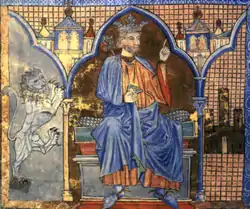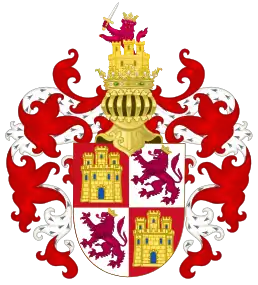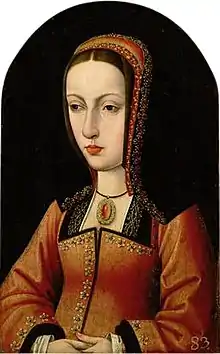List of Castilian monarchs
This is a list of kings and queens of the Kingdom and Crown of Castile. For their predecessors, see List of Castilian counts.

the Iberian Peninsula |
| al-Andalus |
| Almohads |
| Almoravids |
Aragon
|
| Asturias |
Castile
|
| Catalonia |
| Córdoba Emirate · Caliphate |
| Galicia |
| Granada |
| León |
| Majorca |
| Navarre |
| Portugal |
| Spain Medieval · Modern |
| Suebi |
| Taifas |
| Valencia |
| Viguera |
| Visigoths |
Kings of Castile
Jiménez dynasty
| Monarch | Image | Nickname | Reign began | Reign ended | Notes |
|---|---|---|---|---|---|
| Sancho II | .png.webp) |
the Strong | 27 December 1065 | 6 October 1072 | also King of Leon (January- October 1072) |
| Alfonso VI |  |
the Brave | 6 October 1072 | 30 June 1109 | also King of León |
| Urraca |  |
the Reckless | 30 June 1109 | 8 March 1126 | also Queen of León |
House of Ivrea

The following dynasts are descendants, in the male line, of Urraca's first husband, Raymond of Burgundy.
| Monarch | Image | Nickname | Began | Ended | Notes |
|---|---|---|---|---|---|
| Alfonso VII |  |
The Emperor | 10 March 1126 | 21 August 1157 | also King of León |
| Sancho III |  |
The Desired | 21 August 1157 | 31 August 1158 | |
| Alfonso VIII |  |
The Noble | 31 August 1158 | 6 October 1214 |
16 July 1212 won a decisive victory for the Reconquista at the Battle of Las Navas de Tolosa |
| Henry I | .jpg.webp) |
6 October 1214 | 6 June 1217 | ||
| Berengaria | .jpg.webp) |
The Great | 6 June 1217 | 30 August 1217 | abdicated in favor of her son, Ferdinand III; died 1246 |
| Ferdinand III |  |
The Saint | 30 August 1217 | 30 May 1252 | also King of León from 1230; all later kings were King of León as well |
| Alfonso X |  |
The Wise | 30 May 1252 | 4 April 1284 | elected King of the Romans in 1257, a title which he claimed until he renounced it in 1275 |
| Sancho IV | .jpg.webp) |
The Brave | 4 April 1284 | 25 April 1295 | |
| Ferdinand IV | .jpg.webp) |
The Summoned | 25 April 1295 | 7 September 1312 | |
| Alfonso XI |  |
The Just | 7 September 1312 | 26 March 1350 | Infected and killed by the Black Death during the Fifth Siege of Gibraltar (1349–1350) |
| Peter | .jpg.webp) |
The Cruel | 26 March 1350 | 23 March 1369 | Killed by Henry II of Castile |
Succession crisis
Following the death of Peter, a succession crisis arose between Peter's illegitimate half-brother Henry of Trastámara and the Englishman John of Gaunt, a great great grandson of Ferdinand III of Castile, who claimed the title of King of Castile and Léon by virtue of his marriage to Constance, daughter of Peter. Henry took the throne by force, and faced several military actions by John of Gaunt, who had forged an alliance with John I of Portugal in an attempt to enforce his claim, however John of Gaunt was unsuccessful in his campaigns, and Henry established the House of Trastámara as the new ruling dynasty of Castile.
House of Trastámara

Henry II was the illegitimate son of Alfonso XI. He was made count of Trastámara.
| Monarch | Image | Nickname | Began | Ended | Notes |
|---|---|---|---|---|---|
| Henry II | .jpg.webp) |
The Bastard | 23 March 1369 | 29 May 1379 | also claimed the throne from 1366 |
| John I | .jpg.webp) |
29 May 1379 | 9 October 1390 | ||
| Henry III | .jpg.webp) |
The Infirm | 9 October 1390 | 25 December 1406 | |
| John II | .jpg.webp) |
25 December 1406 | 21 July 1454 | ||
| Henry IV | .jpg.webp) |
The Impotent | 21 July 1454 | 11 December 1474 | |
| Isabella I |  |
The Catholic | 11 December 1474 | 26 November 1504 | After ruling for a month on her own, Isabella was then joined by her husband, Ferdinand, who ruled Castile jure uxoris as Ferdinand V. |
| Ferdinand V |  |
The Catholic | 15 January 1475 | 26 November 1504 | Ferdinand was in Aragon when Isabella succeeded to the throne on 11 December 1474. He arrived at Segovia on 2 January 1475 and a negotiation ensued that was arbitrated by Archbishop Carrillo and Cardinal Mendoza. One of the points determined was whether Ferdinand was to be consort or jure uxoris king. In Concordia de Segovia, Carrillo and Mendoza wrote the opinion on 15 January 1475 that Ferdinand was jure uxoris King of Castile.
Succeeding to the throne of Aragon as Ferdinand II on 19 January 1479, Ferdinand then ruled all of non-Portuguese Iberia except Granada (added in 1492) and Navarre (added in 1515) effectively creating a de facto united realm of España. In 1478 established the Spanish Inquisition to displace the Papal Inquisition |
| Joanna |  |
The mad | 26 November 1504 | 12 April 1555 | in name, with her husband Philip I (1504–1506). in confinement, with regent Archbishop Cisneros (1506-1508). in confinement, with her father Ferdinand V (1508-1516). in confinement, with her son Charles I (1516–1555) |
House of Habsburg
.svg.png.webp)
| Monarch | Image | Nickname | Began | Ended | Notes |
|---|---|---|---|---|---|
| Philip I |  |
The Handsome | 26 November 1504 | 25 September 1506 | jure uxoris king ruling on behalf of his wife, Joanna I |
| Charles V |  |
The Emperor | 13 March 1516 | 16 January 1556 | jointly with his mother Joanna I in confinement to 1555, abdicated in favor of his son 1556, died 21 September 1558. |
| Philip II |  |
The Prudent | 16 January 1556 | 13 September 1598 | son of Charles I and Isabella of Portugal |
| Philip III |  |
The Pious | 13 September 1598 | 31 March 1621 | son of Philip II and Anna of Austria |
| Philip IV |  |
The Great | 31 March 1621 | 17 September 1665 | son of Philip III and Margaret of Austria |
| Charles II |  |
The Bewitched | 17 September 1665 | 1 November 1700 | son of Philip IV and Mariana of Austria |
The Crown of Castile existed in its own right within the Spanish crown and with its own law until the arrival of the Bourbon dynasty after the War of Spanish Succession.
See also
| Wikimedia Commons has media related to Monarchs of Castile. |
Further reading
- Barton, Simon. The Aristocracy in Twelfth-Century León and Castile. Cambridge University Press, 1997. Appendix I: "The Counts of Twelfth Century León and Castile and Aragon, pp. 235–302.
.svg.png.webp)